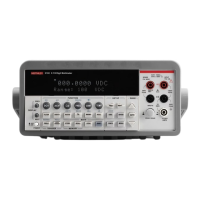Status Byte Register
The summary messages from the status registers and queues are used to set or clear the ap-
propriate bits (B0, B2, B3, B4, B5, and B7) of the Status Byte Register. These bits do not latch,
and their states (0 or 1) are solely dependent on the summary messages (0 or 1). For example, if
the Standard Event Status Register is read, its register will clear. As a result, its summary mes-
sage will reset to 0, which in turn will clear the ESB bit in the Status Byte Register.
Bit B6 in the Status Byte Register is either:
• The Master Summary Status (MSS) bit, sent in response to the *STB? command, indi-
cates the status of any set bits with corresponding enable bits set.
• The Request for Service (RQS) bit, sent in response to a serial poll, indicates which de-
vice was requesting service by pulling on the SRQ line.
For a description of the other bits in the Status Byte Register, see “Common commands,
*STB?”
The IEEE-488.2 standard uses the following common query command to read the Status Byte
Register: *STB?.
When reading the Status Byte Register using the *STB? command, bit B6 is called the MSS
bit. None of the bits in the Status Byte Register are cleared when using the *STB? command to
read it.
The IEEE-488.1 standard has a serial poll sequence that also reads the Status Byte Register
and is better suited to detect a service request (SRQ). When using the serial poll, bit B6 is called
the RQS bit. Serial polling causes bit B6 (RQS) to reset. Serial polling is discussed in more detail
later in this section entitled “Serial Poll and SRQ.”
Any of the following operations clear all bits of the Status Byte Register:
• Cycling power.
• Sending the *CLS common command
Note: The MAV bit may or may not be cleared.
4-26 Remote Operation

